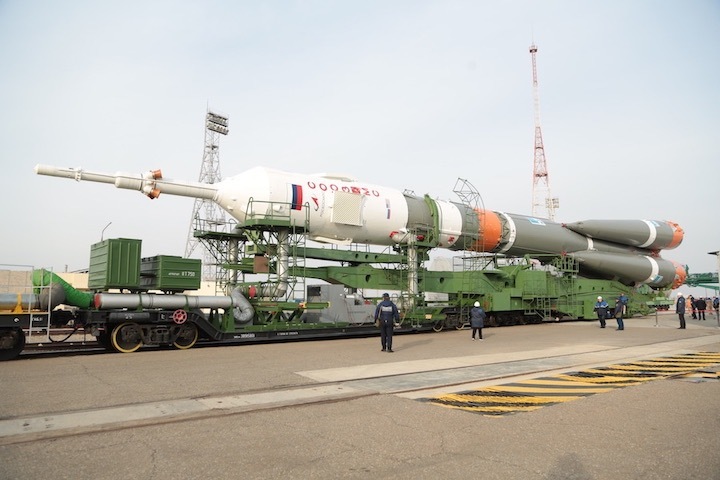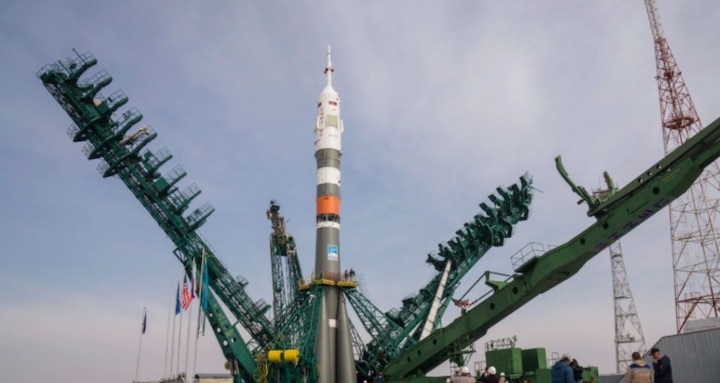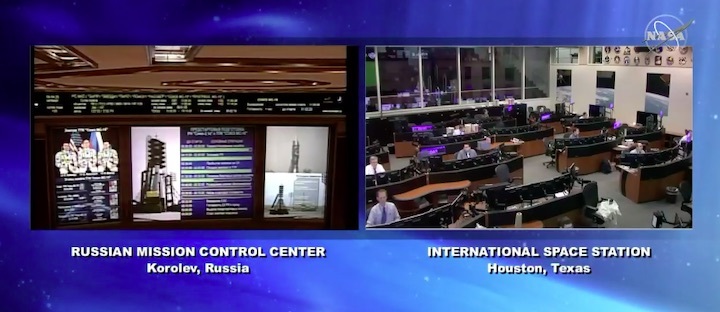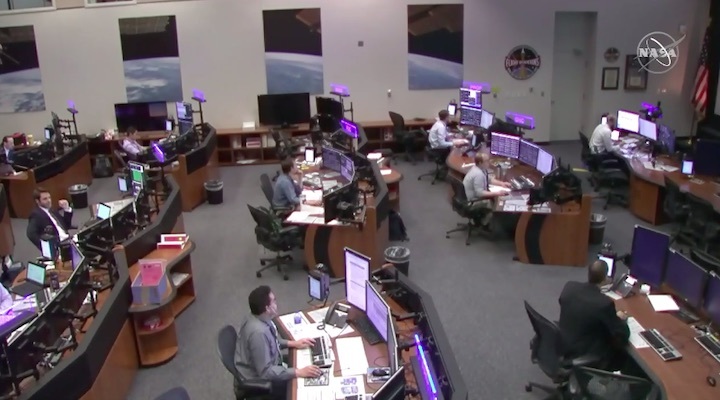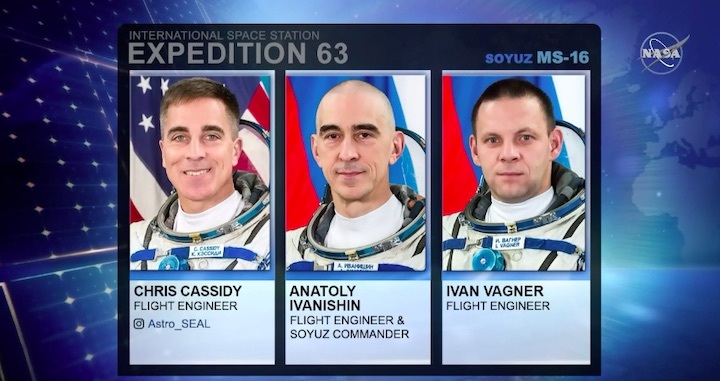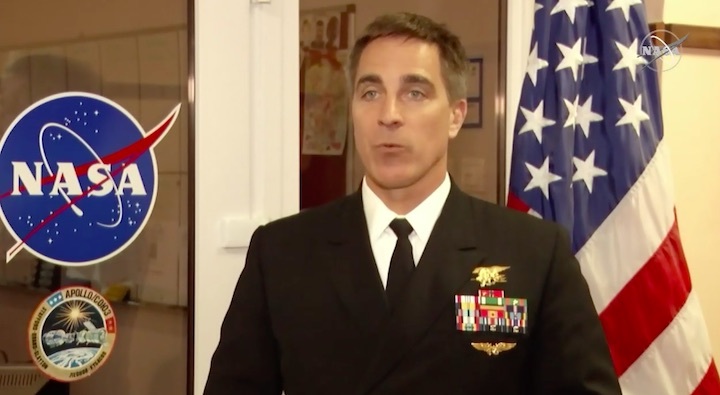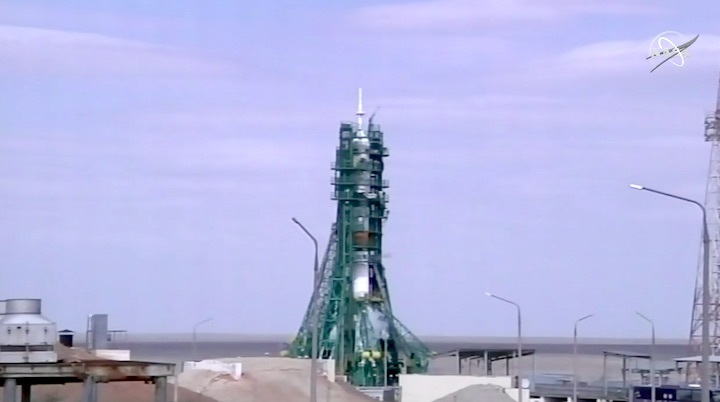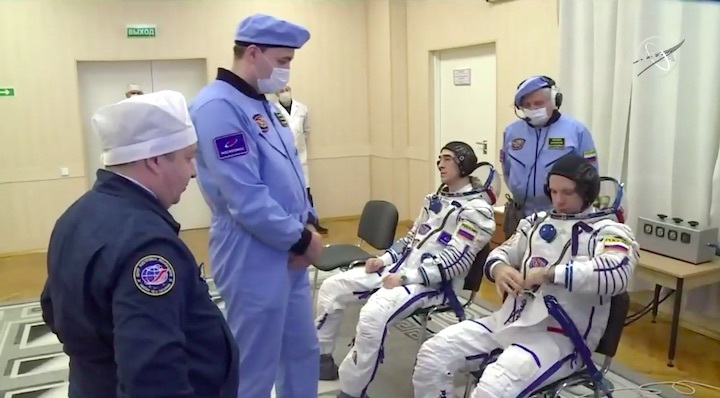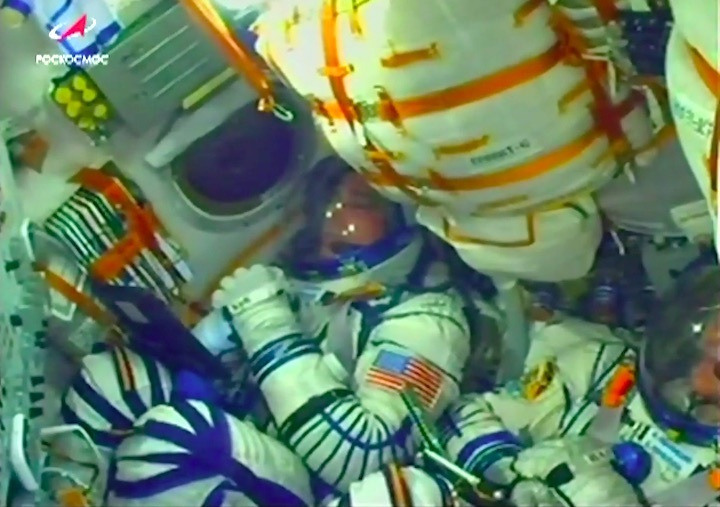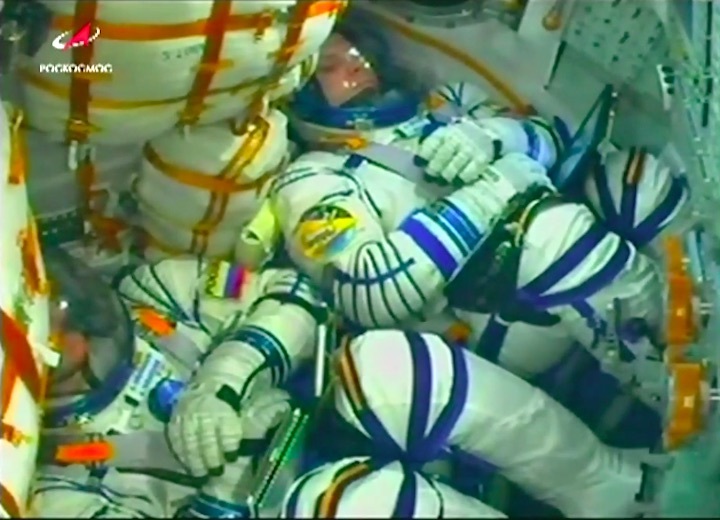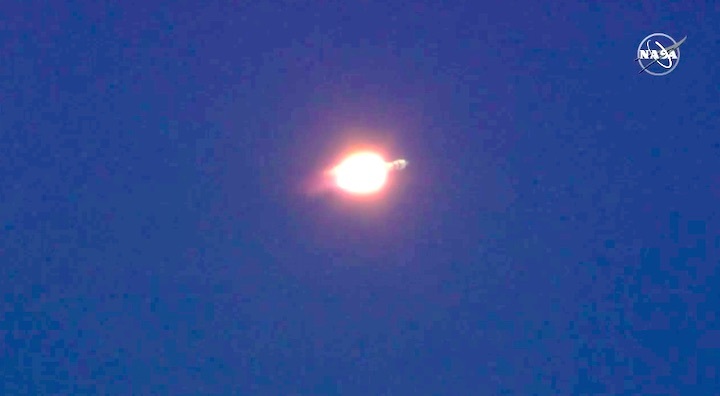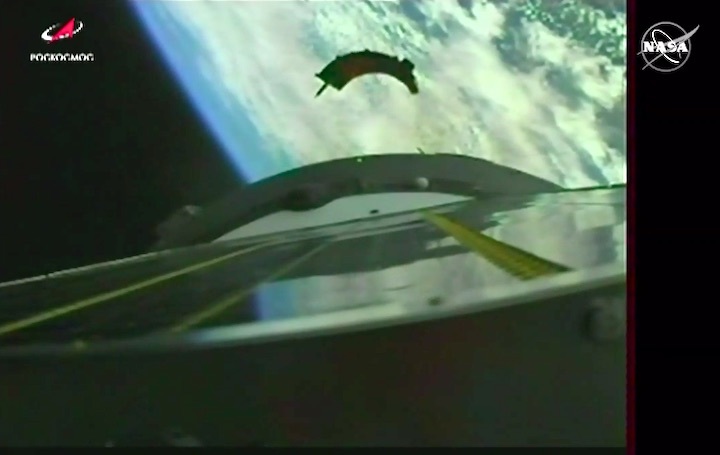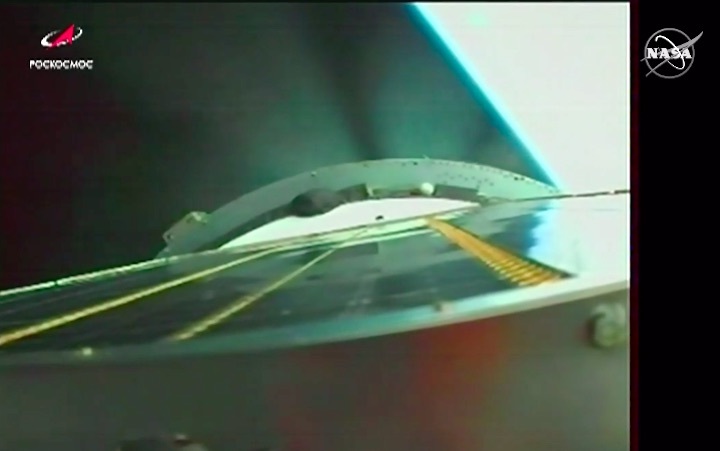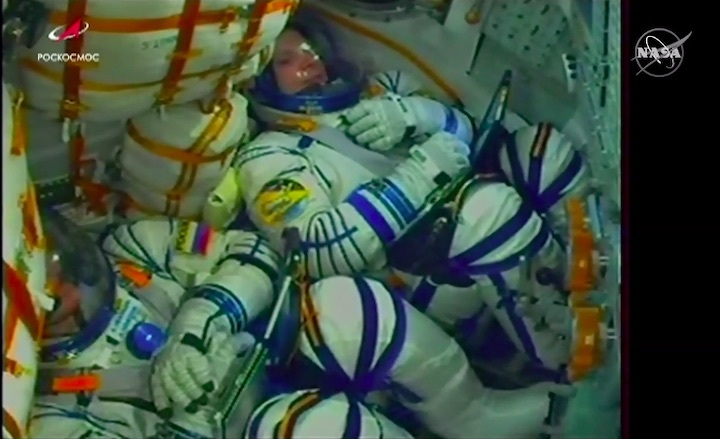5.03.2020
Preparations continue amid crew shuffle for Soyuz MS-16
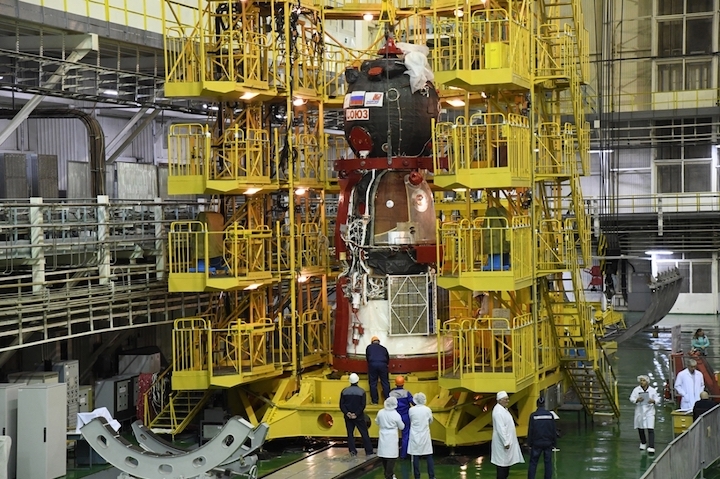
Preparations are underway at the Baikonur Cosmodrome, Star City, and at NASA’s Johnson Space Center for the Soyuz MS-16 mission to the International Space Station (ISS). This comes after the recent announcement that the Prime Crew of Soyuz MS-16 which included Russian Cosmonauts Nikolai Tikhonov (Commander), Andrei Babkin (Flight Engineer 1), and NASA Astronaut Christopher Cassidy (Flight Engineer 2) would have to be broken up. This was due to an eye injury suffered by Nikolai Tikhonov.
Roscosmos said that they would instead replace Tikhonov and Babkin with Anatoli Ivanishin and Ivan Vagner in the Commander and Flight Engineer 1 roles respectively. Cassidy will remain in the Flight Engineer 2 position for MS-16.
This is not the first time Tikhonov has been dropped from a flight, he was dropped from Soyuz MS-04 and Soyuz MS-10 prior to this recent development. Roscosmos hopes to be able to fly Tikhonov on Soyuz MS-17 in order to keep both Tikhonov and Babkin together as a crew because both have trained together for Soyuz MS-16 when they were part of the prime crew. Soyuz MS-17 is currently scheduled for October.
The idea of keeping Tikhonov and Babkin together as a crew for training reasons is not new.
After the Soyuz MS-10 launch abort in October of 2018, Roscosmos and NASA kept Nick Hague and Alexey Ovchinin together to expedite the training process for Soyuz MS-12. Christina Koch, who landed on Soyuz MS-13 in February, launched with Hague and Ovchinin on Soyuz MS-12 in the spring of 2019.
Soyuz MS-16 will be Christopher Cassidy’s third mission to space and his second on a Soyuz. Cassidy previously flew on STS-127 and Soyuz TMA-08M. Between 2015 and 2017 he was the Chief of the Astronaut Office. This will also be Anatoli Ivanishin’s third spaceflight. Ivanishin previously flew on Soyuz TMA-22 (the last flight of the TMA variant) and Soyuz MS-01. MS-16 is Ivan Vagner’s first mission to space.
Once Soyuz MS-15 departs the ISS, Expedition 63 will begin. During the Expedition, Doug Hurley and Bob Behnken are scheduled to launch on the first crewed SpaceX Crew Dragon flight called Demo-2 (DM-2) in early May to ISS.
Unlike Tikhonov and Babkin, Ivanishin and Vagner will not fly to NASA’s Johnson Space Center in Houston for additional ISS training. This makes the additional training for Hurley and Behnken’s extended stay on the ISS even more essential since Cassidy will be the sole American on the ISS after the departure of Soyuz MS-15 and until the arrival of Demo-2.
The Soyuz MS-16 launch will be the first crewed Soyuz mission using the Soyuz 2.1a rocket. The Soyuz 2.1a is a substantial upgrade over the former Soyuz-FG rocket which launched for the final time in Sept 25, 2019. That mission, Soyuz MS-15 consisted of Russian Cosmonaut Oleg Skripochka, NASA Astronaut Jessica Meir, and the first Astronaut from the United Arab Emirates, Hazza Al Mansouri.
This is not the first flight of a Soyuz MS variant spacecraft on a Soyuz 2.1a. There have been numerous launches of unmanned Progress-MS resupply spacecraft on the Soyuz 2.1a. The Soyuz MS-14 mission was an unmanned test flight of a crew-rated Soyuz on a Soyuz 2.1a rocket.
During that flight, Soyuz MS-14 failed on its first docking attempt to the Poisk module, which was due to a faulty signal amplifier on Poisk. This forced Soyuz MS-13 to relocate to from the aft port on Zvezda and Aleksandr Skvortsov manually docked Soyuz MS-13 to Poisk so that Soyuz MS-14 could dock to Zvezda. This was the first Soyuz relocation on the ISS since Soyuz TMA-16M in 2015.
This new type of rocket replaces the analog flight control system (standard on the Soyuz-FG and former Soyuz-U) with a digital one. The Soyuz-2 also gives the Soyuz rocket the ability to roll to the proper launch azimuth, which eliminates the need for the launch gantry to turn to the proper azimuth before launch.
The Soyuz-2 variants are visually different from the Soyuz-FG due to a white stripe on each of the strap-on boosters and the core booster. The Soyuz 2.1b has the newer Fregat Upper-Stage. For Soyuz Arianespace launches, the Soyuz 2.1a is known as the Soyuz ST-A, and the Soyuz 2.1b is known as the Soyuz ST-B. There is also a version called the Soyuz 2.1v which has no strap on boosters and a single NK-33 engine for the first stage.
Unlike recent Soyuz crew missions, the crew will not launch from the historic Site 1/5, which is also known as “Gagarin’s Start.” Instead, the Soyuz MS-16 mission will launch from Site 31/6 like other past Soyuz missions to the ISS. These include Soyuz TMA-06M, Soyuz TMA-15M, and Soyuz MS-02. Site 31/6, although newer than Site 1/5, had its first launch in 1961 and has launched different R-7 variants including the Vosktok, Voskhod, Soyuz-U, Soyuz-FG, Molniya, and now the Soyuz 2.1 and 2.1b.
For the enforceable future, Site 1/5 will not launch crew. Instead, an $84 million renovation of the pad will commence this year and will continue until 2023. The renovation will allow the site to launch the future Soyuz-2M rocket, which is a cheaper variant of the Soyuz 2.1b.
Site 1/5 is the last Soyuz pad that Roscosmos maintains that only launch the now-retired Soyuz-FG rocket, all other pads at Plesetsk and Vostochny Cosmodromes launch the Soyuz-2 series. Plesetsk is the only Cosmodrome that launches the Soyuz 2.1v.
The Soyuz 2.1a rocket for the Soyuz MS-16 flight arrived at the Baikonur Cosmodrome in February. The Soyuz 2.1a built specifically for the Soyuz MS-16 mission is B15000-042 (V15000-042).
A Soyuz 2.1a rocket consists of four strap on boosters as the first stage, one core booster as the second stage, and then a smaller stage on top of the second stage which is the third stage. Finally, at the top is the Soyuz spacecraft itself. All of these different segments of the rocket arrived separately.
The Soyuz spacecraft itself arrived at the Baikonur Cosmodrome in November of 2019. However, the spacecraft remained in storage until Jan 28 when it was moved to the Assembly and Testing building. There it was installed inside a vertical stand, where it is undergoing leak tests, navigation tests, and other tests that need to be done prior to integration and rollout. The serial number for the specific Soyuz spacecraft that is going to be flown on MS-16 is No. 745.
On March 3, the Soyuz MS-16 crew met with the upper management of RSC Energia, the company which built the Soyuz spacecraft. This was for a tea-drinking tradition that usually involves the upper management and the prime crew.
With the rapidly spreading Coronavirus or COVID-19, there may be impacts on the crew and pre-launch preparations at the Baikonur Cosmodrome for Soyuz MS-16. Some of these impacts may be an extension on the planned quarantine before launch day, which is due to the fact that COVID-19 has an incubation period of around 14 days.
If all goes to plan, Anatoli Ivanishin, Ivan Vagner, and Christopher Cassidy will launch to the ISS on April 9.
Quelle: NS
----
Update: 14.03.2020
.
Russian crew swap should not impact next ISS mission

WASHINGTON — As Russian officials give their final approval for the crew of the next Soyuz mission to the International Space Station, NASA’s space station manager says the swap of Russian cosmonauts should not pose a problem for the flight.
The Russian space agency Roscosmos announced March 13 that the primary crew for the next Soyuz mission, consisting of American astronaut Chris Cassidy and Russian cosmonauts Anatoly Ivanishin and Ivan Vagner, had passed the final exams and were approved for flying the mission. They are scheduled to launch to the ISS on the Soyuz MS-16 spacecraft April 9.
Ivanishin and Vagner, though, were assigned to the mission only in February, replacing Nikolai Tikhonov and Andrei Babkin. Both Russian and American officials would only say that a medical issue led to their replacement, although Russian media reported that Tikhonov suffered an injury in training.
In an interview last week during the Next-Generation Suborbital Researchers Conference in Colorado, Kirk Shireman, ISS program manager at NASA, said he did not expect any major difficulties because of the swap. “For a while, Chris Cassidy was training with Ivanishin and Vagner, so he knows them really well,” he said. “Sometimes changing the crew a month out is disruptive, but in this case they know each other pretty well.”
A complicating factor was that Tikhonov and Babkin did additional training to prepare for extended operations of the station with only three people on board. Tikhonov had trained to spacewalk with Cassidy, with Babkin learning how to use the station’s robotic arm, should there been an urgent need for a spacewalk during their mission. Cassidy and the two Russians will likely be the only people on the station for most of their six-month mission, other than during a visit by NASA astronauts Bob Behnken and Doug Hurley on a Crew Dragon test flight no earlier than May.
Shireman said both Ivanishin and Vagner had received similar training, with Ivanishin trained for a spacewalk and Vagner for robotics. “So, we’re in good shape,” he said.
“We expect everything to go smoothly,” he added, a view he said was shared by Roscosmos. “They don’t see any concerns here.”
The coronavirus pandemic could also affect the mission. Russian officials had previously suggested the pre-flight quarantine of the crew could be started earlier than normal in response to the outbreak. Shireman confirmed that such steps were under discussion.
“We expect them to take additional measures to make sure that quarantine is a little tighter,” he said. “We’re ready to deal with that if it happens.”
Quelle: SN
----
Update: 21.03.2020
.
No family, fanfare for NASA astronaut launching next month
A NASA astronaut who's about to leave the planet for six months will blast off without any family or fanfare because of the coronavirus
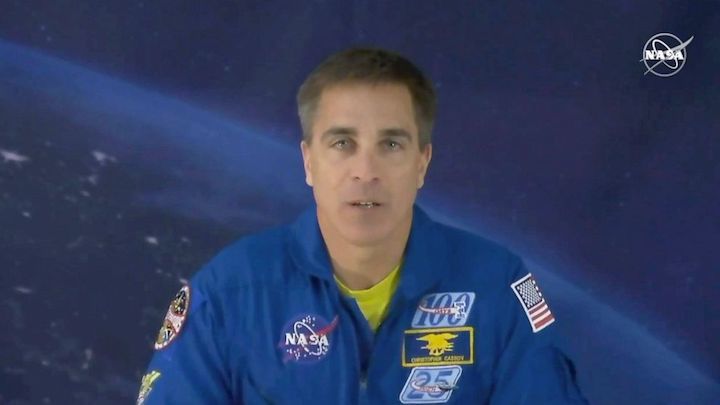
CAPE CANAVERAL, Fla. -- A NASA astronaut who's about to leave the planet for six months will blast off without any family or fanfare because of the coronavirus.
Chris Cassidy said Thursday that he won't have any guests at his April 9 launch from Kazakhstan. He expects to say goodbye in Russia to his wife on Friday, three weeks earlier than planned.
Because of the coronavirus outbreak, she's going back home to Houston. One of his three children, meanwhile, is trying to get back to the U.S. from New Zealand.
There will be a smaller team than usual at the launch pad, too.
“It really is going to be strange," Cassidy told The Associated Press from cosmonaut headquarters in Star City, Russia.
He said he's already in quarantine ahead of his launch to the International Space Station.
“The things that are stressing the rest of the world and the rest of America, are the same things that are stressing me right now,” said Cassidy.
“It's not like any other time in our lives as a generation, really, right?' said the 50-year-old Navy captain and former Navy SEAL. "I'll have my own interesting story to tell in years to come."
Cassidy is also dealing with a rare late-in-the-game crew switch. He'll spend 6 1/2 months on the space station with two Russians assigned to the flight just a month ago, after one of the original cosmonauts suffered an eye injury.
While training together to catch up, Cassidy, Anatoly Ivanishin and Ivan Vagner have been taking precautions to stay germ free, frequently washing their hands and keeping a safe distance from others.
The space station crew will drop from six to three a week after his arrival. It will remain at three people until SpaceX launches two NASA astronauts, as early as May, or another crew arrives on a Russian Soyuz capsule in the fall.
With only three people on board, it promises to be extraordinarily busy.
“That doesn't bother me at all," Cassidy told the AP. “In fact, I'm excited. Bring it on.”
Cassidy, Ivanishin and Vagner leave Tuesday for the Baikonur Cosmodrome in Kazakhstan. They will be isolated there in a special hotel for astronauts, as is customary. But on launch day, there won't be the usual cheering, back-slapping throngs of well-wishers or journalists either.
Their families, bosses and dozens of others normally jam a special room behind a glass wall while the astronauts put on their spacesuits before liftoff.
Not this time.
“We'll be looking through the glass at maybe one video camera or something like this and then we'll get on the bus” to go to a launch pad with a minimal team there, Cassidy said.
As for the Feb. 19 crew switch, Cassidy, from York, Maine, initially was “crushed” by the news. The former chief of NASA's astronaut corps and two-time space flier, Cassidy already knew the backup cosmonauts..
“So no issues there," he said. However, "my heart hurt for my two friends who thought they were so close to a rocket launch and were not going to get one,” he told the AP.
Invanishin, like Cassidy an experienced spaceman, said earlier this week that he's surprised to be suddenly rocketing away, “but life happens.” He said the crew swap could have occurred even closer to launch and so the three have had “some time for the news to settle in.”
Cassidy acknowledges his stress level is higher than usual right now from worrying about his loved ones.
“We're only human," he said, "and we'll work through it and be fine.”
Quelle: abcNews
----
Update: 1.04.2020
.
Soyuz MS-16 on track for April launch amid COVID-19 response

At the Baikonur Cosmodrome in Kazakhstan, Roscosmos and NASA are making preparations for the launch of Soyuz MS-16 and three new crewmembers for the International Space Station while working within new constraints due to the COVID-19 pandemic.
The mission is set to launch on April 9, 2020 at 04:05 EDT (08:05 UTC) from Site 31/6 at the cosmodrome and will mark the first time the Soyuz 2.1a rocket will be used to launch people.
COVID-19, the disease caused by the Coronavirus, has spread around the world and is now a pandemic according to the World Health Organization.
The spaceflight industry is not immune to the pandemic, and some pre-launch traditions for normal Soyuz missions have had to be cancelled or modified, starting with the traditional media press conference in Star City.
Before their departure from Star City to the launch site (amongst a much smaller crowd to bid them farewell), both the prime and backup crews laid flowers at a monument for Yuri Gagarin, the first man to fly into space.
The prime crew for the mission includes cosmonauts Anatoli Ivanishin and Ivan Vagner, as well as NASA astronaut Chris Cassidy.

The backup crew for Soyuz MS-16 is made up of cosmonauts Sergey Ryzhikov, Andrei Babkin, and NASA astronaut Stephen Bowen.
For the Soyuz MS-16 spacecraft, the processing flow has been running per usual. On March 13, RSC Energia announced they had completed vacuum testing on the Soyuz spacecraft in Baikonur.
After this, technicians from both RSC Energia and CC Yuzhny turned their focus to the Soyuz spacecraft’s two solar panels, which are located on the Service module. In order for the test to occur, the panels had to be deployed and extended. Technicians also subjected the solar panels to powerful lights, which tested the solar cells on the panels. These checks and tests occurred inside of the Site 254 complex.
On March 24, both prime and backup crews for Soyuz MS-16 landed at the Krainy airfield, located at the Baikonur Cosmodrome, Kazakhstan. Both crews flew in separate Tupolev TU 204-300s, which were operated by Roscosmos.
Usually, Soyuz crews are met by large crowds upon arrival. However, like other traditions, this had to be cancelled over COVID-19 concerns. Nonetheless, the crew did meet the representatives of the state commission and other officials right after stepping off of the air stairs per usual.

After this, the crew boarded a special bus and left the airfield for crew quarters, where they will be under standard quarantine until launch.
On March 25, the crews underwent fit checks in their Sokol launch and entry suits. These suits are specially tailored for each individual person. An astronaut or cosmonaut only wears their Sokol suits during the ride to and from the ISS inside the Soyuz.
The Sokol suit is designed to save the individual in the event of a cabin decompression and has been in use since Soyuz 12 in 1973.
They were introduced for use on Soyuz missions after the loss of Soviet cosmonauts Georgy Dobrovolsky, Viktor Patsayev, and Vladislav Volkov due to a cabin decompression event when the Orbital Module separated from the Descent Module on Soyuz 11 in 1971.
The same day they arrived at Baikonur, the crews had fit checks in the Soyuz MS-16 spacecraft. The serial number for this specific Soyuz is №.745.
During the fit checks, the prime crew were able to climb into their Soyuz spacecraft and sit in the same seats they will occupy during the launch.
In their seats, the crews were able to go through checklists and further familiarize themselves with their spacecraft. The crew were also in their Sokol suits while they were in the Soyuz MS-16 Descent Module. This was the last time the Soyuz MS-16 crew will sit in their spacecraft before liftoff.
The crews entered the Soyuz spacecraft via a circular hatch on the Orbital Module. Then climbed down the top hatch on the Descent module. This is the same way that the crew will enter the spacecraft on launch day.
The Soyuz was enclosed in a yellow cage-like structure which provides access to different areas of the spacecraft while it is vertical in its testing, checkout, and integration facility.
The backup crew also did the same things that the prime crew did, enabling Roscosmos to switch the two crews in the unlikely event there is some sort of injury or another significant disruption.
In addition to visiting the Soyuz spacecraft and trying on their Sokol suits, the Soyuz MS-16 crew also had the chance to oversee the different clothing, hygiene kits, and other personal materials they will take with them to the ISS.
For the mission, the crew will use a teddy bear wearing a mini Sokol suit as the zero-g indicator. It is a tradition on Soyuz missions to have a simple item for a zero-g indicator.
After crew tests were complete, Roscosmos and RSC Energia announced on March 26 they would commence fueling the Soyuz spacecraft.
The next day, the crew visited a tree planted by Yuri Gagarin, located in the Alley of the Cosmonauts. They laid flowers to remember the first man in space, as March 27 marked the 52nd anniversary of the death of Gagarin.
Per tradition, the crew then planted a tree in the Alley of the Cosmonauts.
Also on March 27, both the prime and backup crews took part in a flag raising ceremony in Baikonur. Three flags were raised, the flag of the Russian Federation, the flag of the United States of America, and the flag of the Republic of Kazakhstan.
Since the Soyuz-FG rocket was retired with the Soyuz MS-15 flight, the Soyuz MS-16 mission will be the first crewed Soyuz mission on a Soyuz 2.1a rocket. The crew will launch from Site 31/6 at Baikonur. The exact Soyuz 2.1a rocket that will launch on Soyuz MS-16 will be B15000-042 (V15000-042).
Fueling of the Soyuz MS-16 spacecraft was completed on March 28. The Soyuz Descent Module’s thrusters run on Hydrogen Peroxide, which slowly degrades over time. The Soyuz’s main engine, which is located on the Propulsion Module, runs on Unsymmetrical dimethylhydrazine (UDMH) as the fuel and Nitrogen Tetroxide (N₂O₄) as the oxidizer.
In the coming days, the Soyuz MS-16 spacecraft will be encapsulated in the fairing/shroud. This will then be followed by the integration of the third stage and the launch escape tower. After this, the third stage will be integrated/mated to the rest of the Soyuz 2.1a rocket.
As a final COVID-19 safety measure, Roscosmos will not allow media and journalists to travel to the Baikonur Cosmodrome to cover the launch.
If all goes according to plan, Soyuz MS-16 will launch at 08:05 UTC on April 6. Once at the ISS, Ivanishin, Vagner, and Cassidy will meet NASA astronauts Jessica Meir, Andrew Morgan, and cosmonaut Oleg Skripochka, who are currently on Expedition 62.
Eventually, Soyuz MS-15 will land in Kazakhstan, leaving Ivanishin, Vagner, and Cassidy on the ISS. Cassidy will be the sole NASA astronaut on the US-segment of the ISS until mid to late-May when Doug Hurley and Bob Behnken launch on the Demo-2 mission for SpaceX’s Crew Dragon spacecraft and NASA’s Commercial Crew Program.
Quelle: NS
----
Update: 7.04.2020
.
Rocket for next space station crew arrives on launch pad in Kazakhstan
A Russian Soyuz-2.1a rocket rolled out to a launch pad Monday at the Baikonur Cosmodrome in Kazakhstan, ready for the first crewed flight to use the modernized Soyuz booster configuration. Liftoff with two Russian cosmonauts and a veteran NASA astronaut is scheduled Thursday on an expedition to the International Space Station.
Preparations for crew and cargo launches to the space station are proceeding amid the global COVID-19 coronavirus pandemic. The orbiting research lab has cost the U.S. government and partner nations more than $100 billion over three decades, and maintaining the outpost requires regular crew rotations and supply deliveries.
But there are restrictions imposed for this week’s crew launch. The crew’s families and media representatives are barred from attending the launch at Baikonur due to concerns about the pandemic. Instead, family members and journalists will watch the launch on television.
The liquid-fueled Soyuz rocket emerged on a railcar from its assembly hangar — known by the Russian acronym MIK — around sunrise Monday for the railroad journey across the Russian-operated cosmodrome to the Site 31 launch complex.
After arriving on the pad deck, a hydraulic erector lifted the Soyuz-2.1a launcher vertical. Folding gantry arms were later raised into position around the Soyuz rocket to provide access for technicians to ready the vehicle for liftoff.
The launch is scheduled at 0805:06 GMT (4:05:06 a.m. EDT) with nearly a million pounds of thrust blazing from 32 engine nozzles.
Liftoff is timed for 1:05:06 p.m. EDT local time at Baikonur, around the time the space station flies over the launch base on the steppes of Central Asia.
Russian Soyuz commander Anatoly Ivanishin, making his third trip into space, will occupy the center seat of the Soyuz MS-16 crew capsule. Flight engineer Ivan Vagner, a first-time space flier, will be to his left, and NASA astronaut Chris Cassidy will sit to his right during the nine-minute climb into orbit.

The Soyuz will shed its launch abort motor and four liquid-fueled boosters less than two minutes into the mission. The capsule will then jettison an aerodynamic shield, and core stage will shut down and separate nearly five minutes after liftoff.
A third stage powered by a four-nozzle RD-0110 engine will inject the Soyuz MS-16 spaceship into a preliminary orbit at around T+plus 8 minutes, 46 seconds. Moments later, the crew capsule will fly free of the rocket’s third stage and unfurl two power-generating solar array wings.
Two major thruster firings by the Soyuz MS-16 spacecraft less than 90 minutes after liftoff will commence the ship’s rendezvous with the space station.
If all goes according to plan, the Soyuz will home in on the space station’s Poisk module using a Kurs rendezvous radar. The ship is scheduled to autonomously dock with the Poisk module at 1415 GMT (10:15 a.m. EDT) Thursday to wrap up a six-hour pursuit from the launch pad at Baikonur.
Ivanishin, Vagner and Cassidy will join the station’s current three-person crew — commander Oleg Skripochka and NASA flight engineers Jessica Meir and Drew Morgan — for more than seven days of joint operations before Skripochka and company return to Earth on April 17 aboard the Soyuz MS-15 spacecraft currently docked at the orbiting research complex.
Cassidy will take command of the space station from Skripochka, kicking off the Expedition 63 mission on the outpost. Cassidy’s crew will remain at the station for an expected 196-day mission before returning to Earth in late October.
The launch Thursday will be the first time a crew rides a Soyuz-2.1a booster into orbit. The Soyuz-FG variant of Russia’s venerable Soyuz launcher, which previous carried Soyuz crews into space, was retired last year.
The Soyuz-2.1a’s upgrades include a modernized digital flight control system, replacing the analog guidance system on older Soyuz models, along with improvements to engine injection systems.
The digital control system allows the Soyuz-2.1a rocket to execute a roll program a few seconds after liftoff to reach the correct azimuth to align its flight path with the space station’s orbit. The Soyuz-FG rocket previously used to launch Soyuz crews had to be rotated into the correct orientation on the launch pad before liftoff.
An unpiloted Soyuz capsule rode a Soyuz-2.1a rocket to orbit last August on a test flight to ensure the upgraded launcher configuration could safely loft station crews into space. The Soyuz-2.1a rocket variant has launched dozens of times since 2004, including flights with Progress cargo freighters on missions to resupply the space station.
The last flight of the Soyuz-FG rocket last September marked the final planned mission to take off from Site 1 at Baikonur. Site 1 is also called Gagarin’s Start because it was the departure point for Yuri Gagarin’s historic mission in 1961, when the Russian cosmonaut became the first human to fly in space.
Russian officials have said they hope to upgrade Site 1 for Soyuz-2 launches. But Site 31, which is outfitted for the Soyuz-2 rocket family and lies in a different section of the sprawling cosmodrome, will be the launch pad used for crewed missions for the foreseeable future.
More photos of the Soyuz rocket’s rollout to the launch pad Monday are posted below.

